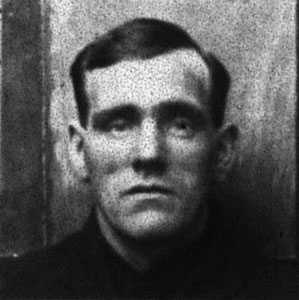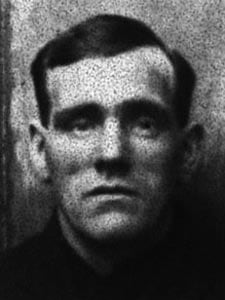Mr Frederick Fleet (Lookout) was born in Liverpool, Lancashire, England on 15 October 1887 and was the illegitimate child of Alice Fleet (b. 29 June 1870).
His mother, Alice Fleet, was born in Liverpool, the daughter of dock labourer Richard Fleet and his wife Ann, née Walkington and came from a large family. By the time of the 1881 census, she was a resident of 99 Hodder Street in Everton.
The exact timeline of events is not clear but Frederick was abandoned by his mother and whilst it is uncertain whether he ever had contact with both his maternal grandparents they both died in the 1890s.
Following the desertion of her son, his mother Alice arrived in the USA on 20 October 1890 aboard the Cephalonia, described as an unmarried millhand. She was married in Chicopee, Hampden, Massachusetts on 5 October 1892 to William Wellstood Burnett (1873-1954), a spectacle maker also from Liverpool. They made their home in Springfield, Massachusetts and welcomed their only child, a daughter named Elizabeth on 29 May 1893. The family later relocated to El Paso, Texas sometime prior to 1910 where William worked as a house painter. She and her husband later lived with their daughter in Albuquerque, New Mexico and Alice died there on 16 April 1953.
His half-sister Elizabeth was married to Stephen Parker and had a son named Bernard Stephen (1916-1994). She was later remarried to George E. Sells (1890-1931), a laundry manager originally from New York and they made their home in Albuquerque. Elizabeth died in 1973.
 Frederick was raised by a succession of foster families and distant relatives via orphanages and Dr Banardo Homes. He first appears on the 1891 census living at 272 Parliament Street in Toxteth Park, Liverpool, the home of Mrs Annie Shaw, a hospital matron. At the age of 12 he was sent to a training ship and appeared on the 1901 census with scores of similarly aged boys under the care of Captain Frederick Charles Gilbert Longdon, a seafarer at Llandegfan in Anglesey, Wales where Fleet was described as "learning a sea life." In 1903 he went to sea as a deck boy, working his way up to Able Seaman. By 1908 he was working aboard Oceanic, a ship he served aboard for four years.
Frederick was raised by a succession of foster families and distant relatives via orphanages and Dr Banardo Homes. He first appears on the 1891 census living at 272 Parliament Street in Toxteth Park, Liverpool, the home of Mrs Annie Shaw, a hospital matron. At the age of 12 he was sent to a training ship and appeared on the 1901 census with scores of similarly aged boys under the care of Captain Frederick Charles Gilbert Longdon, a seafarer at Llandegfan in Anglesey, Wales where Fleet was described as "learning a sea life." In 1903 he went to sea as a deck boy, working his way up to Able Seaman. By 1908 he was working aboard Oceanic, a ship he served aboard for four years.
At the time of the collision, Fleet was on duty in the crow's nest with Reginald Lee, having begun his watch at 10 pm. They had relieved lookouts Archie Jewell and George Symons who advised them to keep a "sharp lookout for small ice."
Just after seven bells, Fleet saw a black mass ahead, immediately struck three bells and telephoned the bridge. He reported, "Iceberg right ahead," and received the reply, "Thank you." While still on the telephone, the ship started swinging to port. The lookouts saw the starboard side of the ship scrape alongside the iceberg and saw ice falling on the decks. They had thought that it had been either a close shave or a near miss. The lookouts remained in the crow's nest until relieved about 20 minutes later.
Fleet then made his way to the Boat Deck where Second Officer Charles Lightoller put him to help Quarter-Master Robert Hichen load and launch lifeboat 6, the first boat to be launched from the port side. After loading some 28 women and children, the boat was lowered into the water. As it was being lowered, Lightoller realised that it was undermanned and called for an experienced seaman. Major Arthur Peuchen volunteered as he had experience as a yachtsman. Lightoller told him "If you are sailor enough to get out there - then go down"; and he proved he was by going down the fall to the boat. In the morning, Lifeboat 6 was picked up by the Carpathia.
Fleet was detained for questioning at both the American and British Inquiries into the sinking. From June 1912 he served briefly as Seaman on the White Star liner Olympic but found that White Star looked at the surviving officers and crew as embarrassing reminders of the recent disaster and he left the company in August 1912. For the next 24 years, Fleet sailed with Union-Castle and various other companies, finishing with the sea in 1936. Ashore, he worked for Harland and Wolff as a shipbuilder and later was the shore Master-at-Arms for Union-Castle Mail Steamship Co.
He was married in 1917 to Eva Ernestine Le Gros (b. 1891), born in St Helier, Jersey and a former resident of St Peter's Port, Guernsey, both in the Channel Islands. The couple had a daughter named Dorothy Frederica Ernestine on 24 November 1918.

In the last years of his life Fleet worked as a part-time street vendor for the Echo newspaper with a pitch on Pound Tree Road, Southampton and he and his wife lived with his brother-in-law Philip Joseph Le Gros (1894-1972). He maintained contact with the Titanic Historical Society and wrote to them often.
On 28 December 1964 Fleet lost his wife. Her brother, with whom the couple lived, then evicted Frederick and in a state of despondency he committed suicide two weeks later, his body being discovered on 10 January 1965. He was buried in an unmarked pauper's grave at Hollybrook Cemetery, Southampton. In 1993 a headstone was erected through donations by The Titanic Historical Society.
His daughter Dorothy was married in 1939 to Michael Patrick Shanley (1909-1972) and had two known children. She died in Southampton in early 1979.


Comment and discuss
Showing 13 posts of 88 total. View all.
Open Thread Leave a Reply